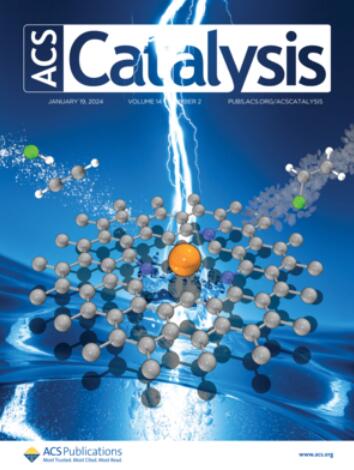Enhancing Deep Mineralization and Chlorine Resistance in Methyl Ethyl Ketone Destruction by Taming Synergy of WOx and Pd Sites
IF 11.3
1区 化学
Q1 CHEMISTRY, PHYSICAL
引用次数: 0
Abstract
Accelerating deep oxidation while restraining the hazardous intermediate formation remains a great challenge in oxygenated volatile organic compounds (OVOCs) catalytic purification. Herein, we found that the modulation of electronic metal–support interactions (EMSIs) in Pd/WOx/Al2O3 catalysts significantly facilitates the deep oxidation of methyl ethyl ketone (MEK) and markedly enhances the CO2 selectivity. Over the Pd/WOx/Al2O3 catalyst, 90% of MEK can be fully oxidized at just 140 °C with a low apparent activation energy (Ea) of 19.65 kJ·mol–1, much superior to that of the commercial Pd/Al2O3 catalyst (Ea of 80.81 kJ·mol–1). The EMSIs promote charge redistribution through the unified Pd-WOx sites, which modulates the d-band structure of highly dispersed Pd sites and strengthens the adsorption and activation of reactants. The positively charged Pd2+ species are dominant in activating MEK molecules at low temperatures, and the stretched W–O bonds enhance the activation of lattice oxygen species to participate in subsequent oxidation, ensuring the rapid total oxidation of MEK molecules via the Mars-van Krevelen mechanism. Furthermore, the bifunctional Pd-WOx sites can also facilitate the dissociation of H2O and CH2Cl2 molecules, enhancing the water-vapor and chlorine resistance of the Pd/WOx/Al2O3 catalyst, which expands the potential toward practical applications. This work sheds significant guidance for researchers to engineer efficacious catalysts toward industrial OVOCs deep elimination.

通过驯服WOx和Pd位点协同作用增强甲基乙基酮破坏的深部矿化和氯抗性
加速深度氧化同时抑制有害中间体的形成是氧化性挥发性有机物(OVOCs)催化净化的一大挑战。本研究发现,Pd/WOx/Al2O3催化剂中电子金属-载体相互作用(EMSIs)的调制显著促进了甲基乙基酮(MEK)的深度氧化,并显著提高了CO2选择性。在Pd/WOx/Al2O3催化剂上,90%的MEK在140℃下就能被完全氧化,其表观活化能(Ea)为19.65 kJ·mol-1,远优于Pd/Al2O3催化剂(Ea为80.81 kJ·mol-1)。emsi通过统一的Pd- wox位点促进电荷重新分配,从而调节高度分散的Pd位点的d波段结构,增强对反应物的吸附和活化。在低温下,带正电的Pd2+在活化MEK分子中占主导地位,拉伸的W-O键增强了晶格氧的活化,参与了随后的氧化,确保了MEK分子通过Mars-van Krevelen机制快速全氧化。此外,双功能Pd-WOx位点还可以促进H2O和CH2Cl2分子的解离,增强Pd/WOx/Al2O3催化剂的抗水蒸气性和抗氯性,扩大了实际应用的潜力。这项工作为研究人员设计有效的工业OVOCs深度消除催化剂提供了重要的指导。
本文章由计算机程序翻译,如有差异,请以英文原文为准。
求助全文
约1分钟内获得全文
求助全文
来源期刊

ACS Catalysis
CHEMISTRY, PHYSICAL-
CiteScore
20.80
自引率
6.20%
发文量
1253
审稿时长
1.5 months
期刊介绍:
ACS Catalysis is an esteemed journal that publishes original research in the fields of heterogeneous catalysis, molecular catalysis, and biocatalysis. It offers broad coverage across diverse areas such as life sciences, organometallics and synthesis, photochemistry and electrochemistry, drug discovery and synthesis, materials science, environmental protection, polymer discovery and synthesis, and energy and fuels.
The scope of the journal is to showcase innovative work in various aspects of catalysis. This includes new reactions and novel synthetic approaches utilizing known catalysts, the discovery or modification of new catalysts, elucidation of catalytic mechanisms through cutting-edge investigations, practical enhancements of existing processes, as well as conceptual advances in the field. Contributions to ACS Catalysis can encompass both experimental and theoretical research focused on catalytic molecules, macromolecules, and materials that exhibit catalytic turnover.
 求助内容:
求助内容: 应助结果提醒方式:
应助结果提醒方式:


